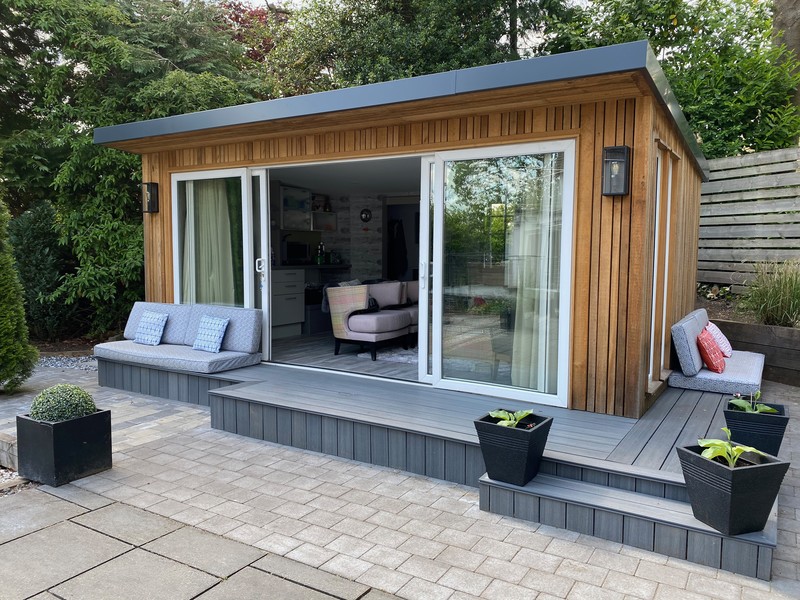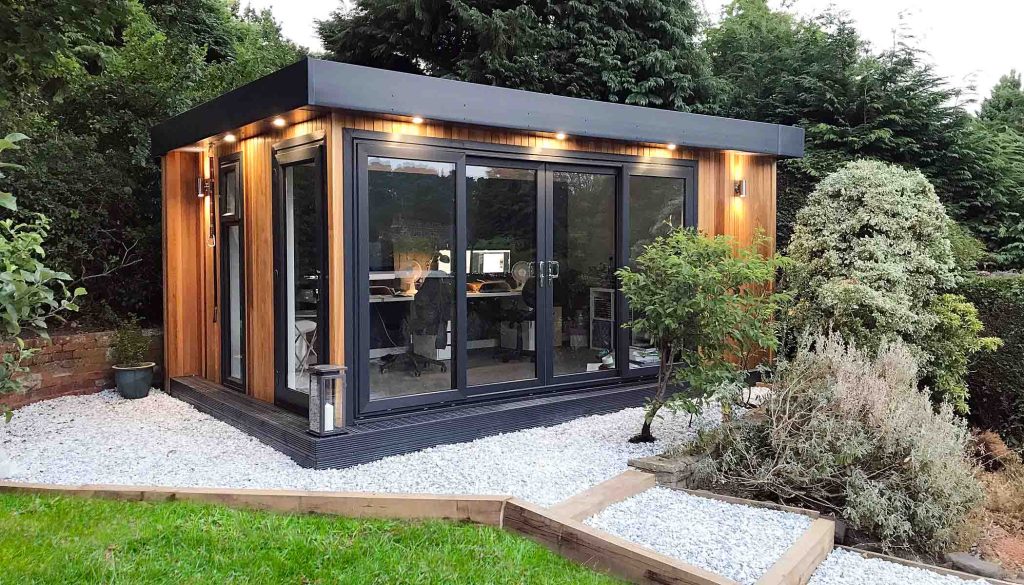In conservation zones, there are particular limitations to preserve the appearance and character of the area. Here are the main aspects to be considered when planning permission is required in conservation areas: General Restrictions:
In conservation areas planning permission is required for any construction or extension that is a permitted development. This could include garden rooms, sheds and other outbuildings.
Size and Scale
If they impact the appearance or character of the area or the character of the area, any structure could need planning permission. In designated zones, there are more strict limits on the dimensions and shape of new structures or extensions.
Location:
Planning permission will be needed for any extensions or buildings that are located on the front and side of a home. Rear of buildings may also need permission if visible from public spaces, or if it impacts the overall appearance of the property.
Materials and design:
The selection of materials and design is crucial in conservation areas. Material selection for any extension or building has to be compatible with the historical or architectural importance of the location. This requires an approval for planning to be granted.
Demolition:
The demolition of buildings or parts of buildings including outbuildings, boundary walls, typically requires approval from the conservation area's planner to ensure that any modifications are consistent with the area's character.
Height Restrictions
In conservation zones, there are more strict height restrictions. Anything that is over 2.5 meters in height (especially within two metres of the boundary line) will probably require planning permission.
The Impact on the Surrounding Environment:
Planning approval is required if the extension or building being proposed significantly impacts the visual appearance or the setting of the conservation area including views from and across the area.
The building is used to:
Even if a garden room or outbuilding is within permissible size limits, its intended use (e.g. for example, as an office space, studio or a habitable space) may require permission for planning in order to accommodate modifications to the property's usage.
Additions and Alterations
Planning permission will be required for all extensions that are greater than the size or volume limit or change the appearance of exteriors. This includes conservatories and other major alterations.
Curtilage Structures:
Conservation areas require the approval of the planning department for all structures within the curtilage. This applies to any extensions, new outbuildings, or modifications.
Trees that are protected:
The trees in conservation areas are protected. If you are planning to build a structure on trees additional permits, such as tree works consent and planning permission may be required.
Local Authority Guidelines
Each conservation area may have specific guidelines and restrictions that are set by the local authority for planning. These may include detailed criteria about what's permitted and not permitted, adapted specifically to the unique features of the region.
In summary, obtaining planning permission in a conservation area involves a detailed evaluation of how a proposed garden room, conservatory, outhouse, garden office, or extension will impact the area's historic and architectural characteristic. Consulting with your local planning authority before beginning the process of planning is crucial to ensure that your project is in compliance with all applicable regulations and guidelines. Have a look at the top rated garden room extension ideas for website recommendations including herts garden rooms, ground screws vs concrete base, outhouses, outhouse buildings, best electric heater for cabin, how to get power to a garden room, garden room, Tring garden rooms, costco garden office, outhouse buildings and more.

What Planning Permission Is Required For Gardens, Rooms Or Other Areas. In Terms Of Listed Structures?
There are more stringent rules and considerations when planning to build conservatories or gardens on a site with a historical building. These are the most crucial points in regards to planning permission.
Most of the time every alteration of extension, alteration or construction within the immediate area of a listed building requires both listed building approval. The listed property's character and uniqueness could be affected by changes.
Historical Character and its impact
Any new or extended construction that might alter the appearance or character of the historical building or the listed structure or its surroundings, requires permission for planning. This includes outbuildings as well as garden rooms.
Materials and Design
The materials and design of the proposed structure must be consistent with the architectural and historical significance of the building that is listed. It could necessitate the use and design of materials from the past. This will also require the approval of a planner.
Proximity to the listed building:
New structures built close to historic sites are scrutinized for their impact on setting and appearance. Planning permission will be needed to ensure that they don't detract from the building's character.
Size and Scale
The proposed garden room, conservatory size, or extension scale must be proportionate to the size of the listed building. Permission for planning and detailed assessment are more likely to be required for larger structures.
Location of the Property:
Planning permission can be affected by the position of a building, regardless of whether it is front, to the side or to the rear of a listed building. Locations that are noticeable or have an important impact on the building's key views will typically be subject to a more thorough review.
Internal Changes
Even if the structure is demolished and the building is not a listed structure, any modifications to the listed building (such as the creation of new access points) are also subject to listed building consent as well as planning approval.
Conservation Area Overlap:
If the listed building is also within a conservation area additional restrictions will apply. To ensure compliance with listed building regulations and conservation area regulations Planning permission is required.
The Building is Used to:
The construction of an outbuilding or a gardenroom may affect the requirement for a planning permit. The use of the space that implies a major modification, like residential accommodation or commercial use will be subject to more careful inspection.
Structural Impact
All constructions that may affect the structural integrity of listed buildings require the permission to plan and the listed-building permit. This ensures that existing and new structures are able to be safely integrated.
Local Authority Guidelines:
Local authorities are required to follow guidelines which define what kind of construction or modification is permissible for listed buildings. These guidelines can only be adhered to with planning permission.
Professional Assessments:
Conservation professionals are typically called upon to carry out detailed analyses for plans of projects on listed properties. These assessments assess the suitability and support for the proposed modifications.
In short planning permission, listed building permits are almost always required when building conservatories, garden rooms outhouses, garden offices or extensions associated with an listed building. An early consultation with local heritage experts and planning authority is crucial to ensure that the regulations are met and the historic and architectural integrity of the property is protected. Have a look at the recommended do i need planning permission to sleep in a garden room? for website recommendations including out house for garden, herts garden rooms, costco garden room, composite summer house, garden rooms hertfordshire, outhouse uk, garden out house, costco outbuildings, what is a garden room, insulated garden buildings and more.

What Planning Permissions Do You Need For Your Garden, Rooms And Other Structures In Relation To Agricultural Land?
If you are thinking of building garden rooms conservatories, outhouses and conservatories garden offices or extensions on agricultural land There are certain permits and restrictions to consider. These are the most important aspects: Change of use:
Land that is designated agriculturally is used for farming and similar activities. Its conversion to residential, or even to be used for garden structures, typically requires planning approval. This is due to the fact that it's a change from its original agricultural purpose.
Permitted Development Rights:
Residential land has a different set of development rights that are permitted than agricultural land. In certain cases agricultural structures can be built without planning approval. However, these rights are only available to structures used for farming.
Scale and size:
The dimensions of the proposed building will determine the need for planning approval. Planning permission is more likely needed for large buildings or structures covering a greater area.
Impact on Agricultural Use
Planning permission is more likely to be required if the new structure interferes with the use of the land, like reducing the amount of land that is available for cropping or livestock.
Green Belt Land:
There are also additional restrictions in place when the property is designated as Green Belt. These restrictions are designed to stop urban sprawl and preserve open space. Any new building or structure built upon Green Belt Land is required to obtain planning permission, and satisfy certain standards.
Design and Appearance
The style and design of the building must be consistent with the rural nature of the region. The planning permit will ensure that the building won't negatively affect the landscape and visual amenity.
Environmental Impact:
It is crucial to take into account the impact on the environment prior to construction on land that is agricultural. If you're applying for planning permission, an environmental impact study could be required to be sure that the new structure doesn't harm local ecosystems.
Proximity to Existing Buildings:
The requirements for planning can be affected due to the close proximity of a planned garden office or room to an existing agricultural building. Structures constructed near the existing structures of a farm may be considered differently from ones located within open fields.
Access and Infrastructure
It is essential to consider the impact of the new building on infrastructure and access such as roads, water and waste management. The planning permission will determine whether the existing infrastructure is able to accommodate a building.
Use Class Order
The law of planning defines the particular applications of land for agriculture. To be in compliance with local laws, changing the classes of use to include non-agricultural structures typically requires approval from the planning department.
Local Planning Policies
Local planning authorities have specific policies regarding agricultural land. These policies determine whether permits are granted for non-agricultural structures considering things like local development plans as well as the needs of communities.
National Planning Policy Framework
In the UK the National Planning Policy Framework gives guidelines on how to use and develop land. The planning permission granted to structures for agriculture will be evaluated according to NPPF which focuses on sustainable development and the protection of rural areas.
In short the simplest way, a permit for planning is required for the building of greenhouses, garden rooms, outhouses and garden offices or extensions to agricultural land. This permission is necessary in order to make sure that land use is changed and to comply with the local and national policies. Consultation with the local planning authority is essential to establish the specific requirements and obtain the necessary approvals. See the most popular outhouse buildings for website recommendations including best heater for log cabin, outhouses for garden, garden rooms hertfordshire, garden office, myouthouse, garden rooms near me, outhouse uk, 4m x 4m garden room, costco garden rooms, garden office electrics and more.
